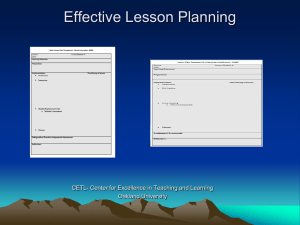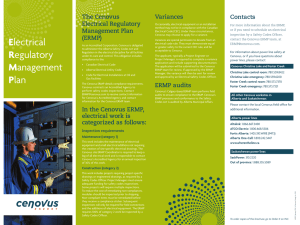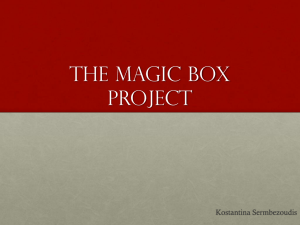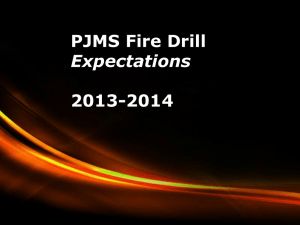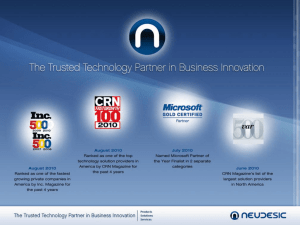Expanding Your Universe with Middleware
advertisement
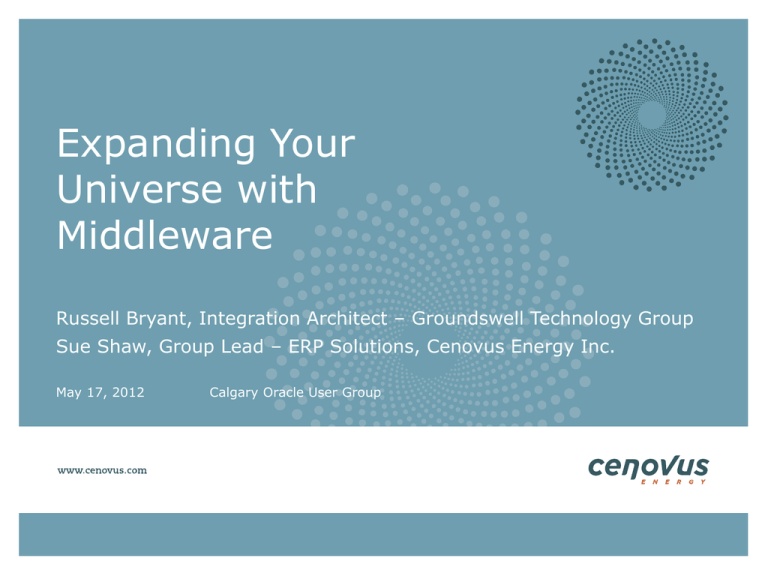
Expanding Your Universe with Middleware Russell Bryant, Integration Architect – Groundswell Technology Group Sue Shaw, Group Lead – ERP Solutions, Cenovus Energy Inc. May 17, 2012 Calgary Oracle User Group Agenda • Who is Cenovus • Cenovus ERP Implementation Program Overview • Cenovus ERP Environment Overview • Who is Groundswell • Current Integration Status • Challenges • Integration Templates • Benefits and Lessons Learned Forward-looking information This presentation contains certain forward-looking statements and other information (collectively “forward-looking information”) about our current expectations, estimates and projections, made in light of our experience and perception of historical trends. Forward-looking information in this presentation is identified by words such as “anticipate”, “believe”, “expect”, “plan”, “forecast” or “F”, “target”, “project”, “could”, “focus”, “vision”, “goal”, “milestone”, “proposed”, “scheduled”, “outlook”, “potential”, “may” or similar expressions and includes suggestions of future outcomes, including statements about our growth strategy and related schedules, projected future value or net asset value, forecast operating and financial results, planned capital expenditures, expected future production, including the timing, stability or growth thereof, anticipated finding and development costs, expected reserves and contingent, prospective or in-place resources estimates, potential dividends and dividend growth strategy, anticipated timelines for future regulatory, partner or internal approvals, forecasted commodity prices, future use and development of technology and projected increasing shareholder value. Readers are cautioned not to place undue reliance on forward-looking information as our actual results may differ materially from those expressed or implied. 2012 guidance is based on an average diluted number of shares outstanding of approximately 759 million. It assumes WTI of US$90.00/bbl; Western Canada Select of US$75.00/bbl; NYMEX of US$3.50/MMBtu; AECO of $3.10/GJ; Chicago 3-2-1 Crack Spread of US$14.50; and exchange rate of $0.975 US$/C$. For the period 2013 to 2021 assumptions include WTI of US$85.00-US$105.00/bbl; Western Canada Select of US$71.00US$85.00/bbl; NYMEX of US$4.00-US$6.00/MMBtu; AECO of $3.30-$5.25/GJ; Chicago 3-2-1 crack spread of US$9.00; exchange rate of $0.98-$1.07 US$/C$; and average number of shares outstanding of approximately 752 million. Developing forward-looking information involves reliance on a number of assumptions and consideration of certain risks and uncertainties, some of which are specific to Cenovus and others that apply to the industry generally. The factors or assumptions on which the forward-looking information is based include: assumptions inherent in our current guidance, available at www.cenovus.com; our projected capital investment levels, the flexibility of capital spending plans and the associated source of funding; estimates of quantities of oil, bitumen, natural gas and liquids from properties and other sources not currently classified as proved; ability to obtain necessary regulatory and partner approvals; the successful and timely implementation of capital projects; our ability to generate sufficient cash flow from operations to meet our current and future obligations; and other risks and uncertainties described from time to time in the filings we make with securities regulatory authorities. The risk factors and uncertainties that could cause our actual results to differ materially, include: volatility of and assumptions regarding oil and gas prices; the effectiveness of our risk management program, including the impact of derivative financial instruments and our access to various sources of capital; accuracy of cost estimates; fluctuations in commodity prices, currency and interest rates; fluctuations in product supply and demand; market competition, including from alternative energy sources; risks inherent in our marketing operations, including credit risks; maintaining a desirable ratio of debt to adjusted EBITDA and debt to capitalization; our ability to access external sources of debt and equity capital; success of hedging strategies; accuracy of our reserves, resources and future production estimates; our ability to replace and expand oil and gas reserves; the ability of us and ConocoPhillips to maintain our relationship and to successfully manage and operate our integrated heavy oil business; reliability of our assets; potential disruption or unexpected technical difficulties in developing new products and manufacturing processes; refining and marketing margins; potential failure of new products to achieve acceptance in the market; unexpected cost increases or technical difficulties in constructing or modifying manufacturing or refining facilities; unexpected difficulties in manufacturing, transporting or refining of crude oil into petroleum and chemical products at two refineries; risks associated with technology and its application to our business; the timing and the costs of well and pipeline construction; our ability to secure adequate product transportation; changes in the regulatory framework in any of the locations in which we operate, including changes to the regulatory approval process and land-use designations, royalty, tax, environmental, greenhouse gas, carbon and other laws or regulations, or changes to the interpretation of such laws and regulations, as adopted or proposed, the impact thereof and the costs associated with compliance; the expected impact and timing of various accounting pronouncements, rule changes and standards on our business, our financial results and our consolidated financial statements; changes in the general economic, market and business conditions; the political and economic conditions in the countries in which we operate; the occurrence of unexpected events such as war, terrorist threats and the instability resulting therefrom; and risks associated with existing and potential future lawsuits, indemnification obligations and regulatory actions against us. The forward-looking information contained in this presentation, including the underlying assumptions, risks and uncertainties, are made as of the date hereof. For a full discussion of our material risk factors, see “Risk Factors” in our 2011 Annual Information Form and “Risk Management” in our most recent Management’s Discussion and Analysis, available at www.sedar.com and www.cenovus.com. Oil & gas information & non-GAAP measures Oil & gas information The contingent resources estimates, effective December 31, 2011, and the discovered bitumen initially-in-place estimates, effective December 31, 2009, were prepared by McDaniel & Associates Consultants Ltd., an independent qualified reserves evaluator, and are based on definitions contained in the Canadian Oil and Gas Evaluation Handbook. For further discussion regarding our (i) contingent resources, see our 2011 Annual Information Form (AIF) and (ii) our total bitumen initially-in-place and all subcategories thereof, see our June 16, 2010 news release, available on SEDAR at www.sedar.com and at www.cenovus.com. Actual resources may be greater than or less than the estimates provided. • Discovered Bitumen Initially-In-Place (56 Bbbls) is that quantity of bitumen that is estimated, as of a given date, to be contained in known accumulations prior to production. The recoverable portion of discovered bitumen initially-in-place includes production, reserves, and contingent resources; the remainder is categorized as unrecoverable. BIIP estimates include unrecoverable volumes and are not an estimate of the volume of the substances that will ultimately be recovered. There is no certainty that it will be commercially viable to produce any portion of the estimate. Contingent Resources are those quantities of bitumen estimated, as of a given date, to be potentially recoverable from known accumulations using established technology or technology under development, but which are not currently considered to be commercially recoverable due to one or more contingencies. Contingencies may include such factors as economic, legal, environmental, political and regulatory matters or a lack of markets. It is also appropriate to classify as contingent resources the estimated discovered recoverable quantities associated with a project in the early evaluation stage. The estimate of contingent resources has not been adjusted for risk based on the chance of development. • Economic contingent resources (8.2 Bbbls) are those contingent resources that are currently economically recoverable based on specific forecasts of commodity prices and costs. In Cenovus’s case, contingent resources were evaluated using the same commodity price assumptions that were used for the 2011 reserves evaluation, which comply with NI 51-101 requirements. Best estimate is considered to be the best estimate of the quantity of resources that will actually be recovered. It is equally likely that the actual remaining quantities recovered will be greater or less than the best estimate. Those resources that fall within the best estimate have a 50% confidence level that the actual quantities recovered will equal or exceed the estimate. Contingent resources are estimated using volumetric calculations of the in-place quantities, combined with performance from analog reservoirs. Contingencies which must be overcome to enable the reclassification of contingent resources as reserves can be categorized as economic, nontechnical and technical. The Canadian Oil and Gas Evaluation Handbook identifies non-technical contingencies as legal, environmental, political and regulatory matters or a lack of markets. The contingencies applicable to our contingent resources are not categorized as economic and for the most part are due to regulatory approval of development projects at our properties, partner sanction and adequate capital funding within five years. Additional information relating to our oil and gas reserves and resources is presented in our AIF, available at www.sedar.com and on our website at www.cenovus.com. Certain natural gas volumes have been converted to barrels of oil equivalent (BOE) on the basis of one barrel (bbl) to six thousand cubic feet (Mcf). BOE may be misleading, particularly if used in isolation. A conversion ratio of one bbl to six Mcf is based on an energy equivalency conversion method primarily applicable at the burner tip and does not represent value equivalency at the well head. Non-GAAP measures This presentation may contain references to non-GAAP measures as identified herein. These measures have been described and presented in order to provide shareholders and potential investors with additional information regarding Cenovus’s liquidity and its ability to generate funds to finance its operations. Readers are encouraged to review our Third Quarter Report to Shareholders, available at www.cenovus.com for a full discussion of the use of each measure. TM is a trademark of Cenovus Energy Inc. Cenovus Overview Tickers – TSX, NYSE CVE Enterprise value $32 billion Shares outstanding 754 MM 2012F production Oil & NGLs 163 Mbbls/d Natural gas 588 MMcf/d 2011 proved & probable reserves 2.7 BBOE Pelican Lake Region Bitumen Economic contingent resources* 8.2 Bbbls Discovered bitumen initially-in-place* 56 Bbbls Lease rights** 1.5 MM net acres P&NG rights 6.1 MM net acres Refining capacity 226 Mbbls/d ALBERTA Alberta oil & gas Borealis Region Christina Lake Region Foster Creek Region SASKATCHEWAN MANITOBA Viking Bakken 2011 Verts Shaunavon Weyburn Values are approximate. Forecast production based on midpoints of 2012 guidance dated December 7, 2011. Cenovus land and bitumen estimates at December 31, 2011. *See advisory. **Includes an additional 0.5 million net acres of exclusive lease rights to lease on our behalf and our assignees behalf. S5 Steam Assisted Gravity Drainage External link to SAGD Video: http://www.cenovus.com/videos/operations/sagd.wmv Internal link here: Christina Lake Foster Creek - Steam Assisted Gravity Drainage - SAGD Foster Creek 2012 Forecast • • • • 53 – 57 Mbbls/d of production $650 – $700 MM of capital $11.25 – $12.45/bbl operating cost 2.0 – 2.2 SOR Forecasts shown are net to Cenovus based on December 7, 2011 guidance document. See advisory. For entertaining view of Cenovus on the Jon Stewart Daily Show go here: http://vimeo.com/25242270 Or search on ‘oilverlords’ Program Overview Cenovus ERP Implementation EnterpriseOne Project Scope: HR Finance Technology Supply Chain Management Capital Projects Asset Management Deliver integrated processes and systems comprising the following business areas Program Key Drivers: • Obsolescence of current ERP both Compliance and Business Risk • Growth in capital spending & asset base One Cenovus Project • Positioning Cenovus to Support Growth January 2011 18 months July 2012 ERP Implementation Facts Supply Chain Management & Capital Projects • Greenfield Implementation • Implementation of JDE 9.0 for procurement and commitments • Upgrade of Primavera P6 for Capital Projects Scheduling • Implementation of Proof of Concept of Primavera PCM for Capital Projects Cost Control Asset Management Human Resources & Finance • Migration from JDE Xe to Maximo • Upgrade from JDE Xe to JDE • Data cleansing, migration, validation • Data cleansing and migration – reduction of 2 TB of data • 16 new integrations between JDE 9.0 and Maximo via Oracle Fusion Middleware • Migration of apprx. 50 integrations to work with JDE 9.0, many very complex • Custom developed Approvals Portal • Implementation of ERP Workspace with Sharepoint 9.0 ERP Environment • General: • • • • Approximately 6500 users, 250 concurrent Mostly 7x24 support required with 2 monthly scheduled outages 9 Head office buildings in Calgary, 18 Field sites 133 interfaces • 47 existing (Tibco, DBLink, etc), 47 UBEs, 32 new SOA and ETL, 7 BPM/SOA • Infrastructure: • • • Will be using WebLogic, AIX 6.1 with LPARs, UNIX Will be on IBM P770s (24-way, 512gb of RAM with NAS disk) PD DB is 3.2TB, F0911 is 360m + archived 250m • Over 1000 custom and modified major objects (Apps/UBEs/Web Services) • JDEdwards specific challenges: • Translates to over 5700 objects • 1200 of the objects come from P2Energy Entelligent Solution and QSoftware ERP Architecture E1 Environments Maximo - Lab TBD Maximo TR Training ORATRN11 App JVMs: trnREP01 trnINT01 trnAUI01 PD900 Pathcode – Self Standing JDE - Lab text Standalone Environment Maximo POC Concept Maximo DV Development ORADEV39 ORATQA08 ORADEV44 App JVMs: sndAdminServer App JVMs: pocAdminServer App JVMs: devREP01 devINT01 devAUI01 OFMW DEVSOA & DEVOSB – Development OFMW LABSOA – Sandbox OFMW SOA Lab JDEPDDTA Pointer to JDESYSPD – Self standing E1 install Maximo SND - Sandbox Maximo TS – Testing ORATST03 App JVMs: tstREP0[12] tstINT0[12] tstAUI0[12] Maximo QA – Quality Assurance Maximo PD – Production ORATQA50 ORAPRD24 App JVMs: qasREP0[12] qasINT0[12] qasAUI0[12] App JVMs: prdREP0[12] prdINT0[12] prdAUI0[12] prdREP1[12] prdINT1[12] prdAUI1[12] OFMW TSTSOA & TSTOSB – Testing OFMW SOATQA & OSBTQA – Quality Assurance OFMW SOAPROD & OSBPROD – Production JDETRDTA Pointer to JDESYSTS (SVM, Sec, DD) JDEFNDTA Pointer to JDESYSTS (SVM, Sec, DD) JDEPSDTA Pointer to JDESYSTS (SVM, Sec, DD) JDEDVDTA Pointer to JDESYSTS (SVM, Sec, DD) JDEPYDTA Pointer to JDESYSTS (SVM, Sec, DD) JDEQADTA Pointer to JDESYSTS (SVM, Sec, DD) JDEPDDTA Pointer to JDESYSPD (SVM, Sec, DD) JDEPDARC Pointer to JDESYSPD (SVM, Sec, DD) TR900 Pathcode - Cloned PY900 Pathcode PS900 Pathcode DV900 Pathcode PY900 Pathcode QA900 Pathcode PD900 Pathcode PD900 Pathcode JDE PS900 Pristine JDE DV900 Development JDE PY900 – Integrated Testing JDE QA900 – Quality Assurance JDE PD900 – Production JDE PDARC900 – Archive JDE TR900 Training text JDE FN900 – Month End Environment on Promotion Path Page 1 Groundswell Group • “We make everything work together, so everything works” • Integration and Middleware; Strategic and Tactical • BI and Information Management (Strategic and Tactical) • Based in Calgary, Alberta; clients all over western Canada • Service provider for Cenovus, responsible for integration and Information Management strategy, oversight and delivery Integration tools in Use • All sorts: • TIBCO (Pub/Sub, request/reply, etc) • ETL • File-based store and forward • Direct database connection • Many custom scripts and programs • Some on radar, many out of sight • Total: 191; JDE related: 164 Current vs Planned Integrations Integrations Objectives • Black Box ERP – JDE, Primavera, Maximo • Agility and Adaptability • Reduce complexity, increase maintainability • Simplify technical stack • Align solutions with vision and roadmaps • Support Cenovus growth plans • Reduce Architecture Debt Integration Challenges • Embracing new technologies & architectural standards • Conversion of many existing integrations • Untangling the web of tightly-coupled point-topoint • Managing various roadmaps, business and technical Past Mistakes • Point-to-point integrations – complexity, impedes agility • Lack of common schemas, business functions and services • Too many diverse approaches and technologies • Tight-coupling through direct database connections • Many integrations outside of governance and oversight Project Challenges • Multiple stakeholders with different maturity levels • Managing different agendas and roadmaps • Negotiating and communicating integration approach • Evangelizing standards and best practices Integration Templates • Similar to a Pattern • Facilitates communication: • Common language • Describes characteristics of integration approaches • Aligned with Standards and Best Practices • Facilitates governance and oversight Integration Templates What is a template? • Describes the integration approach • When it is appropriate for use • Pros & Cons / Issues • Impact to stakeholder Integration Templates How do you choose a template? • Appropriate template choice by stakeholders • Each integration categorized into a template • No quibbling about the details – focus is on categorization • Exceptions can be identified and dealt with Integration Templates Seven Templates for Cenovus • Application to Application - Oracle FMW • Z-Tables Bulk Load into JDE • Store-and-Forward (File based) • Workflow – Oracle FMW with logic • Database to database staged through data repository • Database to database batch ETL through data repository • Direct DB connection – No data repository (only when necessary) Integration Templates Name: • Application to Application (Template Example) When to Use: • 2 or more systems need to collaborate on business functionality • Payload is of a size appropriate for message based integration • Business logic involved in satisfying the request of the calling system • Information needs to be current & exchanged in timely manner Pros • Convenient on-demand access of data in real-time • Validation and access control is provided • Transformation of data into a common view supports reuse Cons • Integration development is more involved than other methods Issues • There may be more endpoint development work Integration Templates Name: • Database to Database Batch (Template Example) When to Use: • Data does not need to be instantly up to date • Each system has its own data repository • Data shared is typically master data, not transactional • No complex business rules are involved in movement of data Pros • Loose coupling through staging area • Governance of data • Well understood in Cenovus Cons • Data Latency • Unable to address complex rules Issues • Requires oversight to manage ETL dependencies Integration Templates Z-Tables Bulk Load into JDE Integration Templates Store-and-Forward (File based) Integration Templates Workflow – Oracle FMW Integration Templates Database to Database Staged through data repository Integration Templates Direct DB Connection – No data repository (Restricted) Integration Templates Benefits: • Streamlines process for selection, change, & signoff approach • Less time on how, more time on what • Impacts and repercussions understood • Allows stakeholders of all types to use common language • Facilitates governance and oversight • Ensures adherence to standards and best practices • Promotes dialog with respect to integration vision Managing Change • Many integrations were implemented other than planned • Some direction changes were very late in the schedule • Templates offer the “short-hand” necessary for change negotiation • Prioritization of requests important • Regular communication of status crucial • Governance committee made up of key stakeholders to help provide direction • Formalized a sign-off process Lessons Learned • Should have socialized the templates in a formal way at first • Misunderstanding of architectural direction created noise • Do not confuse with “Integration Pattern” • Template definition should not be a moving target • Early architecture work should include patterns and templates • Communicate early and often with all stakeholders, IT and Business Current, Planned and Actual Integrations Questions? Example of bulleted slide (32 pt.) • Main bullets should begin with a capital letter and have no punctuation at the end (24 pt.) • sub-bullets should begin with a lowercase letter and have no punctuation at the end (20 pt.) • third bullets should begin with a lowercase letter and have no punctuation at the end (18 pt.) PPT guide try to limit each slide to six lines and six words per line Left align footnote (12 pt.) and place above the dotted line
